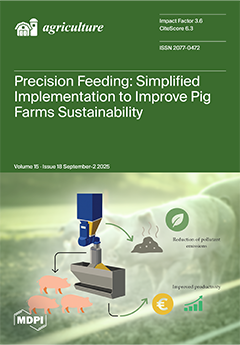Accurate estimation of daily reference evapotranspiration (ET
o) is crucial for sustainable water resource management and irrigation scheduling, especially in water-scarce regions like Arizona. The standardized Penman–Monteith (PM) method is costly and requires specialized instruments and expertise, making it generally impractical for commercial growers. This study developed 35 ET
o models to predict daily ET
o across Coolidge, Maricopa, and Queen Creek in Pinal County, Arizona. Seven input combinations of daily meteorological variables were used for training and testing five machine learning (ML) models: Artificial Neural Network (ANN), Random Forest (RF), Extreme Gradient Boosting (XGBoost), Categorical Boosting (CatBoost), and Support Vector Machine (SVM). Four statistical indicators, coefficient of determination (R
2), the normalized root-mean-squared error (RMSE
n), mean absolute error (MAE), and simulation error (S
e), were used to evaluate the ML models’ performance in comparison with the FAO-56 PM standardized method. The SHapley Additive exPlanations (SHAP) method was used to interpret each meteorological variable’s contribution to the model predictions. Overall, the 35 ET
o-developed models showed an excellent to fair performance in predicting daily ET
o over the three weather stations. Employing ANN10, RF10, XGBoost10, CatBoost10, and SVM10, incorporating all ten meteorological variables, yielded the highest accuracies during training and testing periods (0.994 ≤ R
2 ≤ 1.0, 0.729 ≤ RMSE
n ≤ 3.662, 0.030 ≤ MAE ≤ 0.181 mm·day
−1, and 0.833 ≤ S
e ≤ 2.295). Excluding meteorological variables caused a gradual decline in ET-developed models’ performance across the stations. However, 3-variable models using only maximum, minimum, and average temperatures (T
max, T
min, and T
ave) predicted ET
o well across the three stations during testing (17.655 ≤ RMSE
n ≤ 13.469 and S
e ≤ 15.45%). Results highlighted that T
max, solar radiation (R
s), and wind speed at 2 m height (U
2) are the most influential factors affecting ET
o at the central Arizona sites, followed by extraterrestrial solar radiation (R
a) and T
ave. In contrast, humidity-related variables (RH
min, RH
max, and RH
ave), along with T
min and precipitation (P
r), had minimal impact on the model’s predictions. The results are informative for assisting growers and policymakers in developing effective water management strategies, especially for arid regions like central Arizona.
Full article





